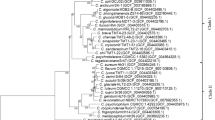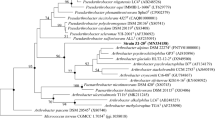Abstract
A straw coloured, motile and Gram-stain-negative bacterium, designated RP-1-19T was isolated from soil of Arctic station, Svalbard, Norway. Based on the phylogenetic analysis of its 16S rRNA gene sequence, strain RP-1-19T formed a lineage within the family Oxalobacteraceae and clustered together within the genus Massilia. The closest members were M. violaceinigra B2T (98.6% sequence similarity), M. eurypsychrophilia JCM 30074T (98.3%) and M. atriviolacea SODT (98.1%). The only respiratory quinone was ubiquinone-8. The principal cellular fatty acids were summed feature 3 (iso-C15:0 2-OH/C16:1ω7c) and C16:0. The major polar lipids were phosphatidylethanolamine, diphosphatidylglycerol and phosphatidylglycerol. The DNA G + C content of the type strain was 63.2%. The average nucleotide identity and in silico DNA–DNA hybridization values between strain RP-1-19T and closest members were ≤ 80 and 23.2%, respectively. The genome was 4,522,469 bp long with 30 scaffolds and 4076 protein-coding genes. The genome showed eight putative biosynthetic gene clusters responsible for various secondary metabolites. Genome analysis revealed the presence of cold-shock proteins CspA and CspC. Presence of cspA and cspC genes in the genome manifest ecophysiology of strain RP-1-19T that may help in cold-adaptation. Based on these data, strain RP-1-19T represents a novel species in the genus Massilia, for which the name Massilia polaris sp. nov. is proposed. The type strain is RP-1-19T (= KACC 21619T = NBRC 114359T).


Similar content being viewed by others
References
Altankhuu K, Kim J (2016) Massilia pinisoli sp. nov., isolated from forest soil. Int J Syst Evol Microbiol 66:3669–3674
Aziz RK, Bartels D, Best AA et al (2008) The RAST server: rapid annotations using subsystems technology. BMC Genomics 9:75
Bankevich A, Nurk S, Antipov D et al (2012) SPAdes: a new genome assembly algorithm and its applications to single-cell sequencing. J Comput Biol 19:455–477
Blin K, Shaw S, Steinke K et al (2019) antiSMASH 5.0: updates to the secondary metabolite genome mining pipeline. Nucleic Acids Res 47:W81–W87
Chaudhary DK, Kim J (2017) Massilia agri sp. nov., isolated from reclaimed grassland soil. Int J Syst Evol Microbiol 67:2696–2703
Dahal RH, Kim J (2018) Fluviicola kyonggii sp. nov., a bacterium isolated from forest soil and emended description of the genus Fluviicola. Int J Syst Evol Microbiol 68:1885–1889
Dahal RH, Kim J (2019) Glaciihabitans arcticus sp. nov., a psychrotolerant bacterium isolated from Arctic soil. Int J Syst Evol Microbiol 69:2492–2497
Doetsch RN (1981) Determinative methods of light microscopy. In: Gerdhardt P, Murray RGE, Costilow RN et al (eds) Manual of methods for general bacteriology. American Society for Microbiology, Washington, pp 21–33
Feng GD, Yang SZ, Li HP, Zhu HH (2016) Massilia putida sp. nov., a dimethyl disulfide-producing bacterium isolated from wolfram mine tailing. Int J Syst Evol Microbiol 66:50–55
Frank JA, Reich CI, Sharma S et al (2008) Critical evaluation of two primers commonly used for amplification of bacterial 16S rRNA genes. Appl Environ Microbiol 74:2461–2470
Gallego V, Sánchez-Porro C, García MT, Ventosa A (2006) Massilia aurea sp. nov., isolated from drinking water. Int J Syst Evol Microbiol 56:2449–2453
Goordial J, Raymond-Bouchard I, Zolotarov Y et al (2015) Cold adaptive traits revealed by comparative genomic analysis of the eurypsychrophile Rhodococcus sp. JG3 isolated from high elevation McMurdo Dry Valley permafrost, Antarctica. FEMS Microbiol Ecol 92:fiv154
Grant JR, Stothard P (2008) The CGView Server: a comparative genomics tool for circular genomes. Nucleic Acids Res 36:W181–W184
Johnston I, Osborn L, Markley R et al (2020) Identification of essential genes for Escherichia coli aryl polyene biosynthesis and function in biofilm formation. bioRxiv. https://doi.org/10.1101/2020.04.22.055939
Kämpfer P, Lodders N, Martin K, Falsen E (2011) Revision of the genus Massilia La Scola et al. 2000, with an emended description of the genus and inclusion of all species of the genus Naxibacter as new combinations, and proposal of Massilia consociata sp. nov. Int J Syst Evol Microbiol 61:1528–1533
Kämpfer P, Lodders N, Martin K, Falsen E (2012) Massilia oculi sp. nov., isolated from a human clinical specimen. Int J Syst Evol Microbiol 62:364–369
Kanehisa M, Goto S (2000) KEGG: Kyoto encyclopedia of genes and genomes. Nucleic Acids Res 28:27–30
Kim J (2014) Massilia kyonggiensis sp. nov., isolated from forest soil in Korea. J Microbiol 52:378–383
Komagata K, Suzuki K (1988) 4 lipid and cell-wall analysis in bacterial systematics. Methods Microbiol 19:161–207
Kumar S, Stecher G, Tamura K (2016) MEGA7: molecular evolutionary genetics analysis version 7.0 for bigger datasets. Mol Biol Evol 33:1870–1874
La Scola B, Birtles RJ, Mallet MN, Raoult D (1998) Massilia timonae gen. nov., sp. nov., isolated from blood of an immunocompromised patient with cerebellar lesions. J Clin Microbiol 36:2847–2852
Lagesen K, Hallin P, Rødland EA et al (2007) RNAmmer: consistent and rapid annotation of ribosomal RNA genes. Nucleic Acids Res 35:3100–3108
Lee H, Kim DU, Park S et al (2017a) Massilia chloroacetimidivorans sp. nov., a chloroacetamide herbicide-degrading bacterium isolated from soil. Antonie Van Leeuwenhoek Int J Gen Mol Microbiol 110:751–758
Lee I, Chalita M, Ha S-M et al (2017b) ContEst16S: an algorithm that identifies contaminated prokaryotic genomes using 16S RNA gene sequences. Int J Syst Evol Microbiol 67:2053–2057
Meier-Kolthoff JP, Auch AF, Klenk H-P, Göker M (2013) Genome sequence-based species delimitation with confidence intervals and improved distance functions. BMC Bioinformatics 14:60
Minnikin DE, O’Donnell AG, Goodfellow M et al (1984) An integrated procedure for the extraction of bacterial isoprenoid quinones and polar lipids. J Microbiol Methods 2:233–241
Muneer F, Rasul I, Azeem F et al (2020) Microbial polyhydroxyalkanoates (PHAs): efficient replacement of synthetic polymers. J Polym Environ 28:2301–2323
Na SI, Kim YO, Yoon SH et al (2018) UBCG: up-to-date bacterial core gene set and pipeline for phylogenomic tree reconstruction. J Microbiol 56:281–285
Raymond-Bouchard I, Goordial J, Zolotarov Y et al (2018) Conserved genomic and amino acid traits of cold adaptation in subzero-growing Arctic permafrost bacteria. FEMS Microbiol Ecol 94:23
Richter M, Rosselló-Móra R (2009) Shifting the genomic gold standard for the prokaryotic species definition. Proc Natl Acad Sci 106:19126–19131
Sasser M (1990) Bacterial identification by gas chromatographic analysis of fatty acid methyl esters (GC-FAME). MIDI Tech Note 101 Newark, MIDI Inc
Schattner P, Brooks AN, Lowe TM (2005) The tRNAscan-SE, snoscan and snoGPS web servers for the detection of tRNAs and snoRNAs. Nucleic Acids Res 33:W686–W689
Schöner TA, Gassel S, Osawa A et al (2016) Aryl polyenes, a highly abundant class of bacterial natural products, are functionally related to antioxidative carotenoids. ChemBioChem 17:247–253
Shen L, Liu Y, Gu Z et al (2015) Massilia eurypsychrophila sp. nov. a facultatively psychrophilic bacteria isolated from ice core. Int J Syst Evol Microbiol 65:2124–2129
Shiner EK, Rumbaugh KP, Williams SC (2005) Interkingdom signaling: deciphering the language of acyl homoserine lactones. FEMS Microbiol Rev 29:935–947
Singh H, Du J, Won K et al (2015) Massilia arvi sp. nov., isolated from fallow-land soil previously cultivated with Brassica oleracea, and emended description of the genus Massilia. Int J Syst Evol Microbiol 65:3690–3696
Smibert RM, Krieg NR (1994) Phenotypic characterization. In: Gerhardt P, Murray RGE, Wood WA, Krieg NR (eds) Methods for general and molecular bacteriology. American Society for Microbiology, Washington, pp 607–654
Sun LN, Yang ED, Cui DX et al (2017) Massilia buxea sp. nov., isolated from a rock surface. Int J Syst Evol Microbiol 67:4390–4396
Tatusova T, DiCuccio M, Badretdin A et al (2016) NCBI prokaryotic genome annotation pipeline. Nucleic Acids Res 44:6614–6624
Wang H, Zhang X, Wang S et al (2018) Massilia violaceinigra sp. nov., a novel purple-pigmented bacterium isolated from glacier permafrost. Int J Syst Evol Microbiol 68:2271–2278
Weon HY, Kim BY, Hong SB et al (2009) Massilia niabensis sp. nov. and Massilia niastensis sp. nov., isolated from air samples. Int J Syst Evol Microbiol 59:1656–1660
Yoon S-H, Ha S-M, Lim J et al (2017a) A large-scale evaluation of algorithms to calculate average nucleotide identity. Antonie Van Leeuwenhoek 110:1281–1286
Yoon SH, Ha SM, Kwon S et al (2017b) Introducing EzBioCloud: a taxonomically united database of 16S rRNA gene sequences and whole-genome assemblies. Int J Syst Evol Microbiol 67:1613–1617
Zhang Z, Schwartz S, Wagner L, Miller W (2000) A greedy algorithm for aligning DNA sequences. J Comput Biol 7:203–214
Zhang YQ, Li WJ, Zhang KY et al (2006) Massilia dura sp. nov., Massilia albidiflava sp. nov., Massilia plicata sp. nov. and Massilia lutea sp. nov., isolated from soils in China. Int J Syst Evol Microbiol 56:459–463
Zheng BX, Bi QF, Hao XL et al (2017) Massilia phosphatilytica sp. nov., a phosphate solubilizing bacteria isolated from a long-term fertilized soil. Int J Syst Evol Microbiol 67:2514–2519
Acknowledgements
We thank Prof. Aharon Oren (The Hebrew University of Jerusalem, Israel) for his expert suggestions concerning the correct species epithet and etymology.
Funding
This work was supported by a National Research Foundation of Korea (NRF) grant funded by the Korean government (MSIT) (No. 2019R1F1A1058501).
Author information
Authors and Affiliations
Corresponding author
Ethics declarations
Conflict of interest
The authors declare that there are no conflicts of interest regarding the publication of this manuscript.
Ethical statement
This study does not describe any experimental work related to human.
Additional information
Publisher's Note
Springer Nature remains neutral with regard to jurisdictional claims in published maps and institutional affiliations.
Supplementary Information
Below is the link to the electronic supplementary material.
Rights and permissions
About this article
Cite this article
Dahal, R.H., Chaudhary, D.K., Kim, DU. et al. Cold-shock gene cspC in the genome of Massilia polaris sp. nov. revealed cold-adaptation. Antonie van Leeuwenhoek 114, 1275–1284 (2021). https://doi.org/10.1007/s10482-021-01600-z
Received:
Accepted:
Published:
Issue Date:
DOI: https://doi.org/10.1007/s10482-021-01600-z




